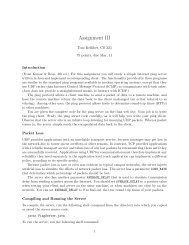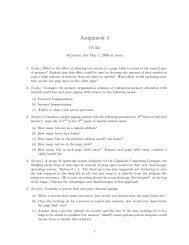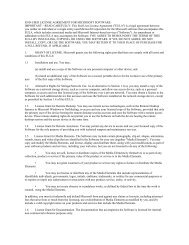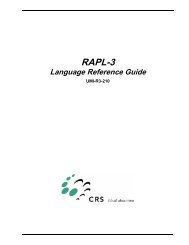Flesh and Machines - Phoenix Goucher
Flesh and Machines - Phoenix Goucher
Flesh and Machines - Phoenix Goucher
You also want an ePaper? Increase the reach of your titles
YUMPU automatically turns print PDFs into web optimized ePapers that Google loves.
Levels of Beingness<br />
Before trying to answer these questions directly for Kismet or one of its descendants, let us return to our dog <strong>and</strong><br />
then some other animals.<br />
We are certainly all quite comfortable granting dogs beingness. They are living creatures, as are mice, elephants, <strong>and</strong><br />
cats. We might debate, however, whether they are conscious. They certainly all seem to have feelings. Our dogs<br />
display fear, excitement, <strong>and</strong> contentment. It is more debatable whether they show gratitude. Most people would be<br />
willing to extend these attributes to all mammals, although mice <strong>and</strong> rats certainly seem less emotionally complex<br />
than dogs or horses. Nevertheless, we can all see a trapped house mouse exhibiting a fearful response, quivering,<br />
<strong>and</strong> breathing, <strong>and</strong> looking around for an escape route. Their fear seems visceral. We can relate to it—it is the same<br />
sort of fear we know that we feel in desperate situations. But visceral fear is not the same as reason. It is an open <strong>and</strong><br />
often debated question whether even chimpanzees can reason. The answer to the question of whether dogs, rats, or<br />
mice can reason tends to fall along the lines of pet owners saying yes <strong>and</strong> scientists saying no.<br />
These animals all have some aspects of beingness, though certainly not all that humans have, even forgetting for the<br />
moment their lack of syntax <strong>and</strong> technology. With this beingness we humans grant these animals certain respect <strong>and</strong><br />
rights. While there is debate on the role of animals, <strong>and</strong> mammals in particular, for scientific experiments, almost no<br />
one argues that cruelty to animals for cruelty's sake is not immoral. In fact, there seems to be a correlation between<br />
those who treat humans with psychopathic cruelty <strong>and</strong> childhood histories of extreme cruelty to animals.<br />
Now consider reptiles. When you quickly approach a lizard, it acts startled <strong>and</strong> runs away. It acts as if it is afraid,<br />
but are we willing to say that the lizard is really afraid? It does not have quite the same sort of reactions that a<br />
mammal has when it is afraid. A lizard has steerable eyes, <strong>and</strong> we can get some cues from it about its direction of<br />
gaze, so we can tell when it is looking in the direction of a source of danger. We may be able to see its rib cage<br />
heaving <strong>and</strong> so detect when its breathing rate increases. But is that because it is afraid, or because it is responding in<br />
a stimulus-response-like manner to danger, gearing up for a fast output of energy in a flee response? Is it really,<br />
really afraid, or does it just share some of the characteristics of being afraid that we have come to underst<strong>and</strong> in<br />
mammals? Perhaps evolution built in the stimulus-response mechanism because that enabled better survival rates.<br />
Perhaps only later with mammals did evolution add real fear.<br />
Like mammals <strong>and</strong> reptiles, fish are vertebrates <strong>and</strong> share a similar body plan with steerable eyes. Rather than lungs,<br />
fish have gills, <strong>and</strong> we certainly get cues about their respiration state when we see them gasping on the ground<br />
behind a fisherman on a jetty. If we are snorkeling underwater, we are totally aware of their startle response <strong>and</strong><br />
their ability to accelerate much faster than we could ever imagine doing. But when they come to rest again a few<br />
seconds later, it is hard to judge that they have been through any traumatic or stressful experience. They seem as<br />
calm as when we first encountered them. Or perhaps it is that they are just as fearful as when we first encountered<br />
them.<br />
If we now look at insects <strong>and</strong> arachnids, it becomes much less clear that they are ever afraid; in fact, sometimes they<br />
seem quite fearless. Insects like cockroaches will flee from oncoming footfalls, but there are no indications<br />
whatsoever of fear. Their eyes are not steerable, <strong>and</strong> many have no discernible head motion relative to their bodies.<br />
And they do not bother to breathe—they simply respire through small tunnels inward from their body surfaces.<br />
Spiders <strong>and</strong> other arachnids sometimes have steerable eyes, but they are too small for us to see them. Like insects,<br />
they often flee from danger, but they do not show any other evidence of fear. On the other h<strong>and</strong>, social insects will<br />
often attack creatures many times their size; their genes have traded off the survival of the individual, who will not<br />
reproduce in any case, for the survival of the society, in which many of their genes will be reproduced.<br />
By the time we get down to worms <strong>and</strong> arrive finally at amoebas, we are probably all willing to say that they do not<br />
have emotional responses. They are not something to which we can map our own fear responses. They are so utterly<br />
different <strong>and</strong> alien that they <strong>and</strong> we are incomparable at the level of our emotions.<br />
These different sorts of animals appear to have different levels of emo tional responses. It also happens that we as a<br />
society tend to treat them with different levels of ethical care.<br />
Chimpanzees are usually viewed as very humanlike. There is great debate about the cruelty of keeping chimpanzees<br />
locked in cages, <strong>and</strong> indeed our zoological gardens have changed their policies on this over the last twenty years.<br />
Nowadays chimpanzees, as well as gorillas <strong>and</strong> orangutans, the other great apes that lie on the same twig of the










